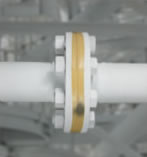
![]()
 |
| FSEC's "Smart Paint" on
hydrogen carrying pipe. Above photo before leak, below photo with leak at dark spot. (Photo: N. Waters) |
|---|
 |
The detection of explosive conditions in hydrogen applications is important for both safety and economic reasons. Cost-effective hydrogen sensor technologies that deliver detection selectivity and sensitivity, dependability and durability, stability and reproducibility, resistance to chemical degradation and real-time response are needed. An examination of the commercially available point-contact hydrogen sensors indicates the majority of these sensors fall into four main categories: catalytic combustion, electrochemical, semi-conducting oxide sensors and thermal conductivity detectors. All of these sensors depend on the interaction of hydrogen with palladium (Pd) or Pd-based alloys.
One kind of hydrogen sensor being developed at FSEC is "Smart Paint." Smart Paint is a special powder that can be painted onto the surface of field lines, flanges, and joints of hydrogen pipelines or vessels to detect minute hydrogen leaks. The paint provides a visual method to detect and locate possible hydrogen leaks that may occur.
For more information, see the "Smart Paint Presentation" [PDF, 582 kb].
Vehicle applications require the development of new sensors with capabilities beyond those of commercially available systems. Areas of most interest include micro-machining and micro-fabrication technology to fabricate miniaturized sensors. In addition, new techniques that allow control and interrogation of each sensor and provide self-calibrating capability are needed.
